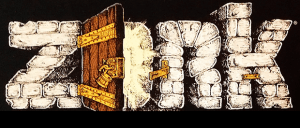 Infocom published three parts of Zork, Zork II and Zork III was one of the earliest text adventure games. And since it was all in TEXT it force people to use fiction and for every player it was his own adventure. But Infocom’s Zork took text adventures at another level. The adventures were coded in ZIL (Zork Implementation Language), a refactoring of MDL (Muddle), itself a dialect of LISP created by MIT students and staff, that were developed in 1977 by members of MIT’s Laboratory for Computer Science Dynamic Modeling System.
Infocom published three parts of Zork, Zork II and Zork III was one of the earliest text adventure games. And since it was all in TEXT it force people to use fiction and for every player it was his own adventure. But Infocom’s Zork took text adventures at another level. The adventures were coded in ZIL (Zork Implementation Language), a refactoring of MDL (Muddle), itself a dialect of LISP created by MIT students and staff, that were developed in 1977 by members of MIT’s Laboratory for Computer Science Dynamic Modeling System.
Thanks to that, Zork adventures were programmed to understand complex answers typed by players to advance in their adventure. Competition in that time used only very basic commands and complex sentences were not recognized. That is why Infocom adventures were best at the time.
Jason Scot proprietor of TEXTFILES.COM archivist that works for Internet Archive published on his github sources of Infocom’s “The Hitchhiker’s Guide to the Galaxy” , all three parts of Zork adventures and many more. As all of Infocom’s games were created using the ZIL, by few people about 25 years ago knowledge about this “dead” language is lost.
On his github Jason wrote note: “It is mostly important to note that there is currently no known way to compile the source code in this repository into a final “Z-machine Interpreter Program” (ZIP) file. There are .ZIP files in some of the Infocom Source Code repositories but they were there as of final spin-down of the Infocom Drive and the means to create them is currently lost.
Throughout its history, Infocom used a TOPS20 mainframe with a compiler (ZILCH) to create and edit language files – this repository is a mirror of the source code directory archive of Infocom but could represent years of difference from what was originally released.
In general, Infocom games were created by taking previous Infocom source code, copying the directory, and making changes until the game worked the way the current Implementor needed. Structure, therefore, tended to follow from game to game and may or may not accurately reflect the actual function of the code.
There are also multiple versions of the “Z-Machine” and code did change notably between the first years of Infocom and a decade later. Addition of graphics, sound and memory expansion are all slowly implemented over time.”
But we are almost sure that in time long lost knowledge how to code in ZIL and how to compile will be discovered.
Jason Scot also published collection of digitized scans from a large cache of documents related to the game publisher Infocom.
Scanned Infocom documents are also available at the Internet archive link: The Infocom Cabinet: Binders and Folders of Infocom, Inc. (1981-1987)
Along with that he even made youtube video:
“Infocom: The Documentary”
We at retro-hardware thanks Jason Scot for his great contribution to adventure gaming history and his work.
Source:Jason Scot github historical source
Source:The ZIL Files
Source:The Infocom Cabinet: Binders and Folders of Infocom, Inc. (1981-1987)
